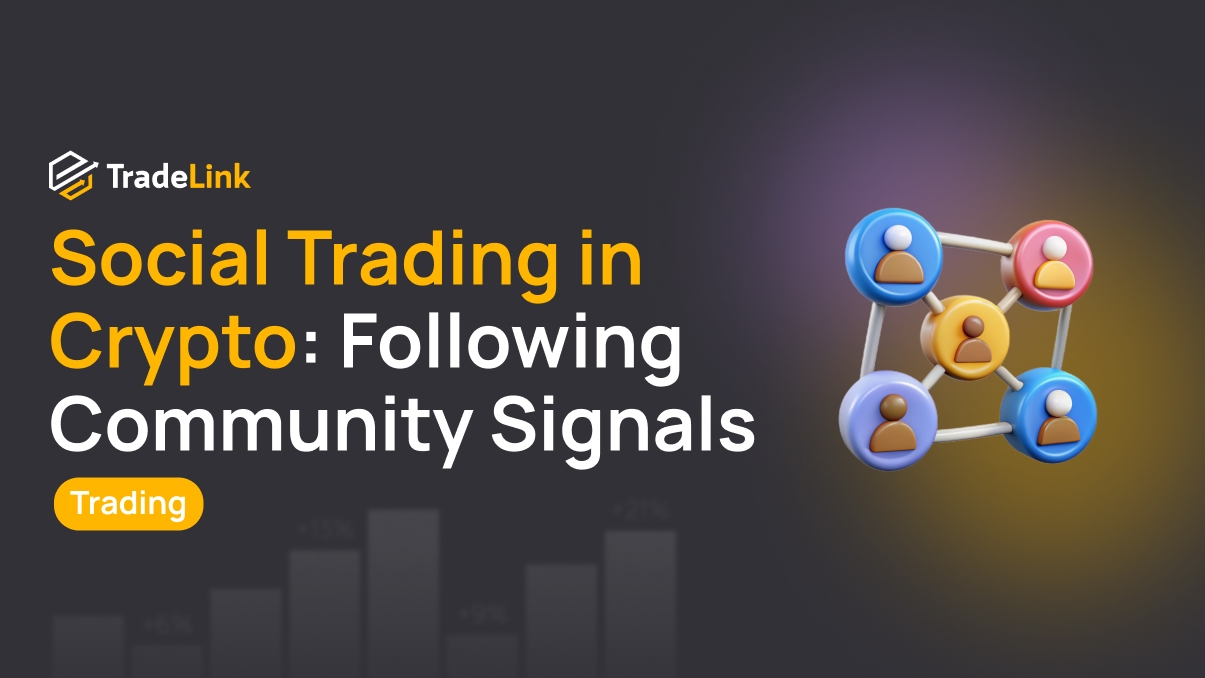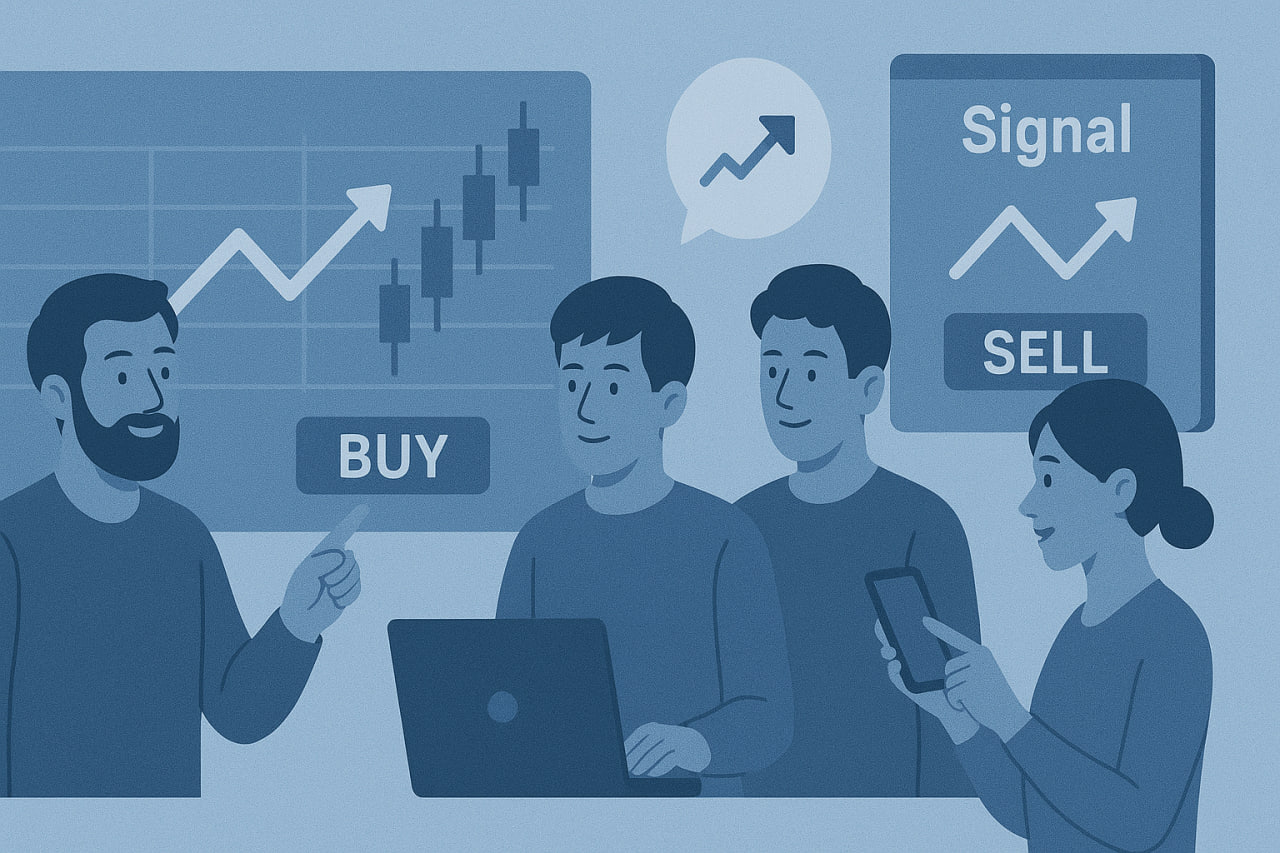Social Trading in Crypto: Following Community Signals

Contents
- Introduction
- What Is Social Trading in Cryptocurrency
- Difference Between Social Trading and Copy Trading
- How Crypto Community Signals Work
- The Role of Influencers and Trading Communities
- Advantages of Social Trading
- Risks and Limitations of Social Trading
- How to Choose a Strategy and Follow Community Signals
- The Future of Social Trading in Crypto Markets
- Conclusion
Introduction
Social trading in cryptocurrency has become one of the most notable trends in recent years. It allows traders to rely not only on their own experience but also on the collective knowledge of the community. Following signals from the crypto community lowers the entry barrier for beginners and helps them learn from the real experience of other traders.
What Is Social Trading in Cryptocurrency

Social trading refers to the exchange of strategies and trading signals within the crypto community. Unlike independent analysis, the focus here is on trusting the experience of others and using the ideas of fellow market participants. In a way, it is a form of social investing.
Key Features:
-
Access to other traders’ strategies and signals
-
The ability to learn from others’ mistakes and successes
-
Building a crypto community around the shared activity of trading
Difference Between Social Trading and Copy Trading
Many confuse social trading with copy trading, but these are two different concepts. Copy trading implies the automatic replication of a chosen trader’s deals, while social trading is broader and includes exchanging opinions, analysing signals, and jointly discussing strategies.
| Criterion | Social Trading | Copy Trading |
|---|---|---|
| Mechanics | Exchange of signals and ideas | Automatic trade copying |
| Trader’s role | Active, analyzing signals | Passive, no analysis |
| Educational value | High | Minimal |
| Risk | Depends on the quality of signals | Depends on the chosen trader |
How Crypto Community Signals Work

Community signals are generated in chats, forums, and specialised platforms. The most popular channels remain Telegram groups, Discord communities, and services where traders share strategies.
Main Sources of Signals:
-
Telegram and Discord groups with trading signals
-
Specialised social trading platforms
-
Posts from crypto influencers on Twitter and YouTube
-
AI-based signal services
The key task for a trader is learning how to distinguish reliable data from questionable information. Assessing a signal provider’s reputation and past performance becomes an important filter when choosing which signals to follow.
The Role of Influencers and Trading Communities
Crypto influencers and community leaders often shape market sentiment. Their signals can trigger waves of buying or selling, especially among novice traders.
However, relying too heavily on individual leaders carries risks. To avoid one-sided perspectives, it’s better to follow multiple sources and analyse a broader range of opinions.
Advantages of Social Trading

For many beginners, social trading has become an entry point into the market. It provides opportunities that would otherwise require years of practice, analysis, mistakes, and financial losses to acquire.
Main Benefits:
-
Quick access to professional trading strategies
-
Accelerated learning through observing experienced traders
-
Support within the crypto community and knowledge exchange
-
Lower entry barrier for market newcomers
Risks and Limitations of Social Trading
Despite its appeal, social trading has drawbacks. The danger lies in the fact that not all community signals are reliable.
Key Risks:
-
Dependence on others’ decisions and loss of independence
-
Risk of unreliable or manipulative signals
-
Potential financial losses from following poor strategies
-
Psychological traps: herd mentality and overconfidence
How to Choose a Strategy and Follow Community Signals

To successfully use social investing in crypto, it’s crucial not only to find sources of high-quality, trustworthy signals but also to build your own risk management approach.
Practical Recommendations:
-
Check the history of signals and trader’s statistics:
Dishonest traders may hide losing signals by deleting them from chats or channels, creating the illusion of success to maintain their reputation. -
Use multiple sources of signals for comparison:
No single source can cover the entire market outlook. Relying on several perspectives provides a broader view and a more accurate understanding of the situation. -
Limit the share of capital allocated to others’ strategies:
Social trading, like any form of trading, requires proper risk management. Never risk your entire capital, even if a signal source seems trustworthy.
Everyone makes mistakes, and without risk limits, they can be very costly. -
Develop your own strategies alongside using signals:
Apply the skills and insights gained from social trading in practice. This helps deepen your knowledge, sharpen your analysis, and build independence.
The Future of Social Trading in Crypto Markets
In the coming years, social trading is likely to evolve through AI integration, automated signal evaluation, and decentralised systems.
Web3 platforms are already offering tools for signal analysis secured by smart contracts. This will improve transparency, reduce manipulation risks, and make collective trading safer.
Conclusion
Social trading in crypto has become an important tool for both beginners and experienced traders. It combines the benefits of collective knowledge with risks tied to trusting others’ decisions. The best results are achieved when traders use community signals as part of their broader strategy, while maintaining independence and a critical mindset.